Nokia N95 Service Manual level 1-2

Nokia Customer Care
Service Manual
RM-320 (Nokia N95 8GB; L3&4)
Mobile Terminal
Part No: (Issue 1)
COMPANY CONFIDENTIAL
Copyright © 2007 Nokia. All rights reserved.

|
|
|
RM-320 |
|
|
|
Amendment Record Sheet |
Amendment Record Sheet |
|
|
|
|
|
|
|
Amendment No |
Date |
Inserted By |
Comments |
Issue 1 |
08/2007 |
M. Hautaniemi |
|
|
|
|
|
Page ii |
COMPANY CONFIDENTIAL |
Issue 1 |
|
Copyright © 2007 Nokia. All rights reserved. |
|

RM-320
Copyright
Copyright
Copyright © 2007 Nokia. All rights reserved.
Reproduction, transfer, distribution or storage of part or all of the contents in this document in any form without the prior written permission of Nokia is prohibited.
Nokia, Nokia Connecting People, and Nokia X and Y are trademarks or registered trademarks of Nokia Corporation. Other product and company names mentioned herein may be trademarks or tradenames of their respective owners.
Nokia operates a policy of continuous development. Nokia reserves the right to make changes and improvements to any of the products described in this document without prior notice.
Under no circumstances shall Nokia be responsible for any loss of data or income or any special, incidental, consequential or indirect damages howsoever caused.
The contents of this document are provided "as is". Except as required by applicable law, no warranties of any kind, either express or implied, including, but not limited to, the implied warranties of merchantability and fitness for a particular purpose, are made in relation to the accuracy, reliability or contents of this document. Nokia reserves the right to revise this document or withdraw it at any time without prior notice.
The availability of particular products may vary by region.
IMPORTANT
This document is intended for use by qualified service personnel only.
Issue 1 |
COMPANY CONFIDENTIAL |
Page iii |
|
Copyright © 2007 Nokia. All rights reserved. |
|

RM-320
Warnings and cautions
Warnings and cautions
Warnings
•IF THE DEVICE CAN BE INSTALLED IN A VEHICLE, CARE MUST BE TAKEN ON INSTALLATION IN VEHICLES FITTED WITH ELECTRONIC ENGINE MANAGEMENT SYSTEMS AND ANTI-SKID BRAKING SYSTEMS. UNDER CERTAIN FAULT CONDITIONS, EMITTED RF ENERGY CAN AFFECT THEIR OPERATION. IF NECESSARY, CONSULT THE VEHICLE DEALER/ MANUFACTURER TO DETERMINE THE IMMUNITY OF VEHICLE ELECTRONIC SYSTEMS TO RF ENERGY.
•THE PRODUCT MUST NOT BE OPERATED IN AREAS LIKELY TO CONTAIN POTENTIALLY EXPLOSIVE ATMOSPHERES, FOR EXAMPLE, PETROL STATIONS (SERVICE STATIONS), BLASTING AREAS ETC.
•OPERATION OF ANY RADIO TRANSMITTING EQUIPMENT, INCLUDING CELLULAR TELEPHONES, MAY INTERFERE WITH THE FUNCTIONALITY OF INADEQUATELY PROTECTED MEDICAL DEVICES. CONSULT A PHYSICIAN OR THE MANUFACTURER OF THE MEDICAL DEVICE IF YOU HAVE ANY QUESTIONS. OTHER ELECTRONIC EQUIPMENT MAY ALSO BE SUBJECT TO INTERFERENCE.
•BEFORE MAKING ANY TEST CONNECTIONS, MAKE SURE YOU HAVE SWITCHED OFF ALL EQUIPMENT.
Cautions
•Servicing and alignment must be undertaken by qualified personnel only.
•Ensure all work is carried out at an anti-static workstation and that an anti-static wrist strap is worn.
•Ensure solder, wire, or foreign matter does not enter the telephone as damage may result.
•Use only approved components as specified in the parts list.
•Ensure all components, modules, screws and insulators are correctly re-fitted after servicing and alignment.
•Ensure all cables and wires are repositioned correctly.
•Never test a mobile phone WCDMA transmitter with full Tx power, if there is no possibility to perform the measurements in a good performance RF-shielded room. Even low power WCDMA transmitters may disturb nearby WCDMA networks and cause problems to 3G cellular phone communication in a wide area.
•During testing never activate the GSM or WCDMA transmitter without a proper antenna load, otherwise GSM or WCDMA PA may be damaged.
Page iv |
COMPANY CONFIDENTIAL |
Issue 1 |
|
Copyright © 2007 Nokia. All rights reserved. |
|

RM-320
ESD protection
ESD protection
Nokia requires that service points have sufficient ESD protection (against static electricity) when servicing the phone.
Any product of which the covers are removed must be handled with ESD protection. The SIM card can be replaced without ESD protection if the product is otherwise ready for use.
To replace the covers ESD protection must be applied.
All electronic parts of the product are susceptible to ESD. Resistors, too, can be damaged by static electricity discharge.
All ESD sensitive parts must be packed in metallized protective bags during shipping and handling outside any ESD Protected Area (EPA).
Every repair action involving opening the product or handling the product components must be done under ESD protection.
ESD protected spare part packages MUST NOT be opened/closed out of an ESD Protected Area.
For more information and local requirements about ESD protection and ESD Protected Area, contact your local Nokia After Market Services representative.
Issue 1 |
COMPANY CONFIDENTIAL |
Page v |
|
Copyright © 2007 Nokia. All rights reserved. |
|

RM-320
Care and maintenance
Care and maintenance
This product is of superior design and craftsmanship and should be treated with care. The suggestions below will help you to fulfil any warranty obligations and to enjoy this product for many years.
•Keep the phone and all its parts and accessories out of the reach of small children.
•Keep the phone dry. Precipitation, humidity and all types of liquids or moisture can contain minerals that will corrode electronic circuits.
•Do not use or store the phone in dusty, dirty areas. Its moving parts can be damaged.
•Do not store the phone in hot areas. High temperatures can shorten the life of electronic devices, damage batteries, and warp or melt certain plastics.
•Do not store the phone in cold areas. When it warms up (to its normal temperature), moisture can form inside, which may damage electronic circuit boards.
•Do not drop, knock or shake the phone. Rough handling can break internal circuit boards.
•Do not use harsh chemicals, cleaning solvents, or strong detergents to clean the phone.
•Do not paint the phone. Paint can clog the moving parts and prevent proper operation.
•Use only the supplied or an approved replacement antenna. Unauthorised antennas, modifications or attachments could damage the phone and may violate regulations governing radio devices.
All of the above suggestions apply equally to the product, battery, charger or any accessory.
Page vi |
COMPANY CONFIDENTIAL |
Issue 1 |
|
Copyright © 2007 Nokia. All rights reserved. |
|

RM-320
Company Policy
Company Policy
Our policy is of continuous development; details of all technical modifications will be included with service bulletins.
While every endeavour has been made to ensure the accuracy of this document, some errors may exist. If any errors are found by the reader, NOKIA MOBILE PHONES Business Group should be notified in writing/e- mail.
Please state:
•Title of the Document + Issue Number/Date of publication
•Latest Amendment Number (if applicable)
•Page(s) and/or Figure(s) in error
Please send to:
NOKIA CORPORATION
Nokia Mobile Phones Business Group
Nokia Customer Care
PO Box 86
FIN-24101 SALO
Finland
E-mail: Service.Manuals@nokia.com
Issue 1 |
COMPANY CONFIDENTIAL |
Page vii |
|
Copyright © 2007 Nokia. All rights reserved. |
|

RM-320
Battery information
Battery information
Note: A new battery's full performance is achieved only after two or three complete charge and discharge cycles!
The battery can be charged and discharged hundreds of times but it will eventually wear out. When the operating time (talk-time and standby time) is noticeably shorter than normal, it is time to buy a new battery.
Use only batteries approved by the phone manufacturer and recharge the battery only with the chargers approved by the manufacturer. Unplug the charger when not in use. Do not leave the battery connected to a charger for longer than a week, since overcharging may shorten its lifetime. If left unused a fully charged battery will discharge itself over time.
Temperature extremes can affect the ability of your battery to charge.
For good operation times with Ni-Cd/NiMh batteries, discharge the battery from time to time by leaving the product switched on until it turns itself off (or by using the battery discharge facility of any approved accessory available for the product). Do not attempt to discharge the battery by any other means.
Use the battery only for its intended purpose. Never use any charger or battery which is damaged.
Do not short-circuit the battery. Accidental short-circuiting can occur when a metallic object (coin, clip or pen) causes direct connection of the + and - terminals of the battery (metal strips on the battery) for example when you carry a spare battery in your pocket or purse. Short-circuiting the terminals may damage the battery or the connecting object.
Leaving the battery in hot or cold places, such as in a closed car in summer or winter conditions, will reduce the capacity and lifetime of the battery. Always try to keep the battery between 15°C and 25°C (59°F and 77° F). A phone with a hot or cold battery may temporarily not work, even when the battery is fully charged.
Batteries' performance is particularly limited in temperatures well below freezing. Do not dispose of batteries in a fire!
Dispose of batteries according to local regulations (e.g. recycling). Do not dispose as household waste.
Page viii |
COMPANY CONFIDENTIAL |
Issue 1 |
|
Copyright © 2007 Nokia. All rights reserved. |
|

RM-320
Nokia N95 8GB; L3&4 Service Manual Structure
Nokia N95 8GB; L3&4 Service Manual Structure
1 General Information
2 Service Tools and Service Concepts
3 BB Troubleshooting and Tuning Guide
4 RF troubleshooting
5 Camera Module Troubleshooting
6 System Module
Issue 1 |
COMPANY CONFIDENTIAL |
Page ix |
|
Copyright © 2007 Nokia. All rights reserved. |
|

RM-320
Nokia N95 8GB; L3&4 Service Manual Structure
(This page left intentionally blank.)
Page x |
COMPANY CONFIDENTIAL |
Issue 1 |
|
Copyright © 2007 Nokia. All rights reserved. |
|
Nokia Customer Care
1 — General Information
Issue 1 |
COMPANY CONFIDENTIAL |
Page 1 –1 |
|
Copyright © 2007 Nokia. All rights reserved. |
|

RM-320
General Information
(This page left intentionally blank.)
Page 1 –2 |
COMPANY CONFIDENTIAL |
Issue 1 |
|
Copyright © 2007 Nokia. All rights reserved. |
|

RM-320
General Information
Table of Contents
RM-320 product selection...................................................................................................................................... |
1–5 |
RM-320 product features and sales package....................................................................................................... |
1–5 |
Mobile enhancements............................................................................................................................................ |
1–8 |
Technical specifications...................................................................................................................................... |
1–10 |
Transceiver general specifications ............................................................................................................... |
1–10 |
Main RF characteristics for GSM850/900/1800/1900 and WCDMA 2100 phones ..................................... |
1–10 |
Battery endurance.......................................................................................................................................... |
1–11 |
List of Tables |
|
Table 1 Audio .......................................................................................................................................................... |
1–8 |
Table 2 Car............................................................................................................................................................... |
1–9 |
Table 3 Data ............................................................................................................................................................ |
1–9 |
Table 4 GPS........................................................................................................................................................... |
1–10 |
Table 5 Messaging............................................................................................................................................... |
1–10 |
Table 6 Power ...................................................................................................................................................... |
1–10 |
Table 7 Carrying................................................................................................................................................... |
1–10 |
Issue 1 |
COMPANY CONFIDENTIAL |
Page 1 –3 |
|
Copyright © 2007 Nokia. All rights reserved. |
|

RM-320
General Information
(This page left intentionally blank.)
Page 1 –4 |
COMPANY CONFIDENTIAL |
Issue 1 |
|
Copyright © 2007 Nokia. All rights reserved. |
|
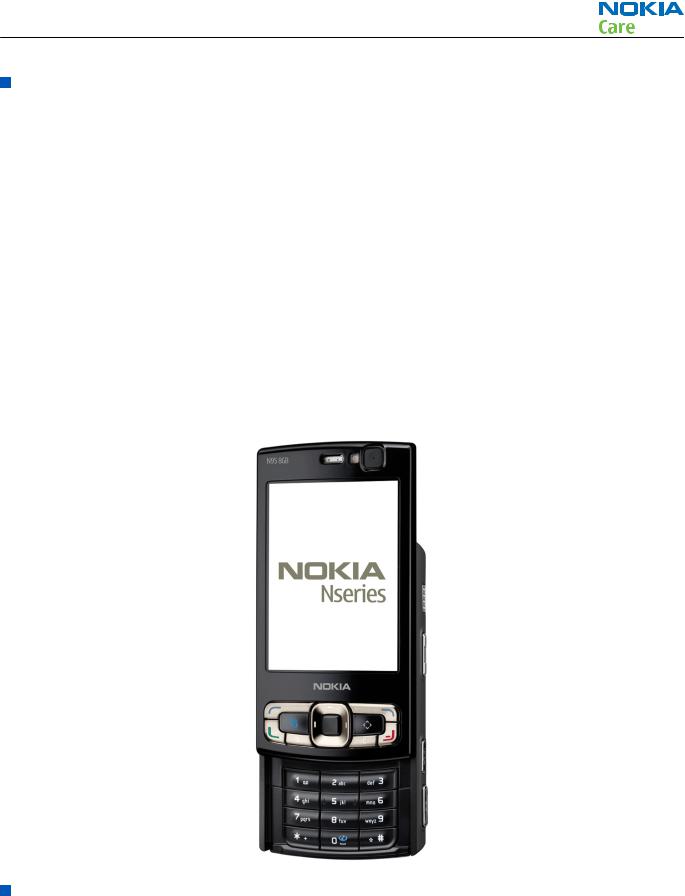
RM-320
General Information
RM-320 product selection
RM-320 is a WCDMA/GSM dual mode handportable phone, supporting EGSM850/900/1800/1900 and WCDMA2100.
RM-320 is a 3GPP Release 5 terminal supporting WCDMA/HSDPA, EGPRS and GPRS data bearers. For WCDMA HSDPA the maximum bit rate is up to 3.6 Mbps for downlink and 384 kbps for uplink with simultaneous CS speech or CS video (max. 64 kbps).
For 2G and 2.5G networks the RM-320 is a Class A EGPRS DTM MSC 11 which means maximum download speed of up to 236.8 kbps simultaneously with speech or Class B EGPRS MSC 32 which means a in maximum download speed of up to 296kbit/s with EGPRS, and up to 107kbit/s with GPRS.
According to GSM standard 05.05 it responds to class 4 (max. 2W) in GSM 850 and EGSM 900 class 1 (1W) in DCS 1800 and class 1 in PCS 1900. RM-320 supports EGPRS (EDGE) class B as well as Bluetooth 2.0 EDR standard.
RM-320 supports two way video calls with two integrated cameras, one on the front and one on the back.
RM-320 is an MMS (Multimedia Messaging Service) enabled multimedia computer with a large 2.6’’ QVGA (240 x 320 pixels) TFT colour display and an integrated 5 Megapixel auto focus camera. The MMS implementation follows the OMA MMS standard release 1.2. The Browser is a highly advanced internet browser also capable of viewing operator domain XHTML Mobile Profile (MP) content.
RM-320 uses Symbian 9.2 operating system and supports also MIDP Java 2.0 & CLDC1.1, providing a good platform for compelling 3rd party applications.
RM-320 product features and sales package
Imaging
Main camera:
Issue 1 |
COMPANY CONFIDENTIAL |
Page 1 –5 |
|
Copyright © 2007 Nokia. All rights reserved. |
|

RM-320
General Information
•Sensor: CMOS, 5 megapixel
•Carl Zeiss Optics: Tessar™ lens
•F number/Aperture: F2.8
•Focal length: 5.6 mm 35 mm (35 mm equiv.)
•Focus range: 10 cm ~ infinity
•Macro focus distance: 10-50 cm
•Shutter speed: Mechanical shutter 1/1000~1/4 s
•Lens protection: Sliding cover with activation Video:
•Video resolution: up to VGA at 30 fps
•Audio recording: AAC (AMR for MMS)
•Video stabilization
•Video clip length: 59 min 59 sec
•Video file format: .mp4 (default) , .3gp (for MMS)
•White balance: automatic, sunny, cloudy, incandescent, fluorescent
•Scene: Auto, Night
•Colour tone: normal, sepia, B&W, vivid, negative
•Zoom (optical/digital): 1x / up to 10x (VGA 4X)
Photo:
•Still image resolutions: up to 5 megapixel: 2592 x 1944
•Still image file format: JPEG/EXIF
•Auto focus
•Auto exposure: center weighted AE
•Image orientation: automatic
•Exposure compensation: +2 ~ -2EV at 0.5 step
•White balance: automatic, sunny, cloudy, incandescent, fluorescent
•Scene: auto, sports, portrait, close-up, landscape, night, user defined
•Colour tone: normal, sepia, B&W, vivid, negative
•Zoom (digital): up to 20x (5Mpix 6X)
Other camera features:
•LED flash and recording indicator
•Front camera, CIF (352 x 288) sensor
Edit
• On device Photo editor and Video editor (manual & automatic)
View
•Large 2.8” QVGA (240 x 320 pixels) TFT colour display, ambient light detector - used to optimize display and keypad backlight brightness and power consumption
•Slideshow from Gallery
Page 1 –6 |
COMPANY CONFIDENTIAL |
Issue 1 |
|
Copyright © 2007 Nokia. All rights reserved. |
|

RM-320
General Information
Share
•Nokia XpressShare - share effortlessly from Gallery or after capture via Email, Bluetooth, MMS or IrDA
•Direct connection to TV via cable or WLAN (UPnP)
•Video call and video sharing support. (WCDMA services)
•Online Album : Image/Video uploading from Gallery
• Nokia XpressPrint – direct printing via USB (PictBridge), Bluetooth (BPP), and WLAN (UPnP
Store
•Nokia XpressTransfer – easy to transfer and organize photos and video between your device and a compatible PC
•Photoshop Album 3.0 Starter Edition (PC)
•Nokia Lifeblog (mobile & PC)
Music
•Digital music player: supports MP3/AAC/M4A/WMA with playlists
•Dedicated music keys
•OMA DRM 2.0 & WMDRM support for music
•Stereo FM radio (87.5-108MHz)
•Integrated stereo handsfree speakers
•Stereo headset HS-45 & music remote AD-43
Media
•Mobile TV experience with video streaming
•Full web browser support (HTML)
•Visual Radio™ support
Productivity
Messaging:
•E-mail (SMTP, IMAP4, POP3), MMS, SMS Office applications:
•Viewing of email attachments – .doc, .xls, .ppt, . pdf PIM:
•Contacts, calendar, to-do, notes, recorder, calculator, clock, converter Synchronization:
•Local/Remote (using SyncML)
•Data: Calendar, Contacts, To-do, Notes, E-mail
•PC Applications: Microsoft Outlook (98, 2000, 2002, 2003), Outlook Express, Lotus Organizer (5.0, 6.0), Lotus Notes (5.0, 6.0)
Call management:
•Call logs, speed dial, voice dialling (with SIND) and voice commands
•Nokia Push to Talk (PoC)
Issue 1 |
COMPANY CONFIDENTIAL |
Page 1 –7 |
|
Copyright © 2007 Nokia. All rights reserved. |
|
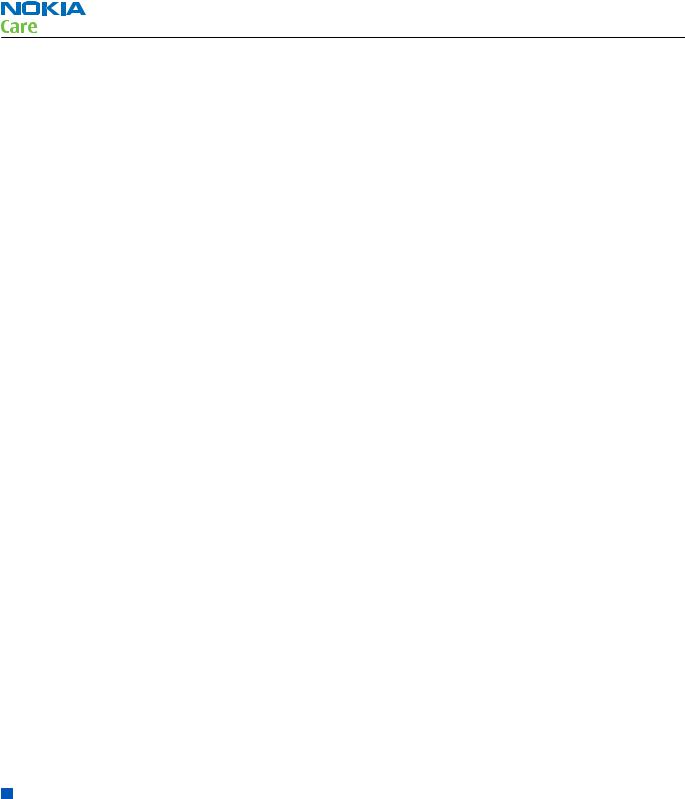
RM-320
General Information
Connectivity
•WLAN - IEEE802.11 g/b with UPnP support
•Mini USB type B interface with USB 2.0 full speed
•3.5mm stereo headphone plug and TV out support (PAL/NTSC)
•Bluetooth wireless technology 2.0 with A2DP stereo audio
•Infrared (SIR)
Add-on software framework
•Symbian 9.2 OS
•Nokia Series 60, 3rd edition, feature pack 3.1
•Java: MIDP2.0
•C++ and Java SDKs
Additional technical specifications
•Vibrating alert
•3GPP Rel 5 compliant
•Speech codecs supported in WCDMA: AMR
•Speech codecs supported in GSM: FR AMR/HR AMR/EFR/FR/HR
•WCDMA HSDPA 2100 MHz with simultaneous voice and packet data (PS max speed DL/UL= 3.6Mbps/ 384kbps, CS max speed 64kbps)
•Dual Transfer Mode (DTM) support for simultaneous voice and packet data connection in GSM/EDGE networks. Simple class A, multi slot class 11, max speed DL/UL: 118.4/118.4kbits/s
•EGPRS class B, multi slot class 32, (5 Rx + 3 Tx / Max Sum 6), max speed DL/UL= 296 / 177.6 kbits/s
•GPRS class B, multi slot class 32 (5 Rx + 3 Tx / Max Sum 6), max speed DL/UL= 107 / 64.2 kbits/s
•GPS
Sales package
• Transceiver RM-320
• Charger (AC-5)
• Battery (BL-6F)
• Music headset (HS-45 and AD-54)
• Connectivity cable (DKE-2)
• Video out cable (CA-75U)
Mobile enhancements
|
Table 1 Audio |
|
|
|
|
Enhancement |
|
Type |
Music headset |
|
HS-45 with AD-54 3.5mm stereo plug |
|
|
|
Basic headset |
|
HS-41 |
|
|
|
Stereo headset |
|
HS-48 |
|
|
|
Wireless headset |
|
HS-26W |
|
|
|
Page 1 –8 |
COMPANY CONFIDENTIAL |
Issue 1 |
|
Copyright © 2007 Nokia. All rights reserved. |
|

RM-320
General Information
Enhancement |
|
Type |
Bluetooth headset |
|
BH-900 |
|
|
|
|
|
BH-800 |
|
|
|
|
|
STEREO BH-501 |
|
|
|
|
|
BH-601 |
|
|
|
|
|
MONO BH-200 |
|
|
|
|
|
BH-202 |
|
|
|
|
|
BH-207 |
|
|
|
|
|
BH-300 |
|
|
|
|
|
BH-302 |
|
|
|
|
|
BH-500 |
|
|
|
|
|
BH-600 |
|
|
|
|
|
BH-700 |
|
|
|
|
|
BH-801 |
|
|
|
Wireless stereo gateway |
|
AD-42W |
|
|
|
Music headphone |
|
HS-61 |
|
|
|
Advanced headphone |
|
HS-62 |
|
|
|
Music speaker |
|
MD-3 |
|
|
|
Mini speaker |
|
MD-4 |
|
|
|
|
Table 2 Car |
|
|
|
|
Enhancement |
|
Type |
Mobile charger |
|
DC-4 |
|
|
|
Wireless plug-in car handsfree |
|
HF-6W |
|
|
|
|
|
HF-33W |
|
|
|
|
|
HF-35W |
|
|
|
Car kit |
|
Nokia 616 |
|
|
|
Multimedia car kit |
|
CK-20W |
|
|
|
|
Table 3 Data |
|
|
|
|
Enhancement |
|
Type |
Connectivity cable |
|
DKE-2 |
|
|
|
Video connectivity cable |
|
CA-75U |
|
|
|
Issue 1 |
COMPANY CONFIDENTIAL |
Page 1 –9 |
|
Copyright © 2007 Nokia. All rights reserved. |
|
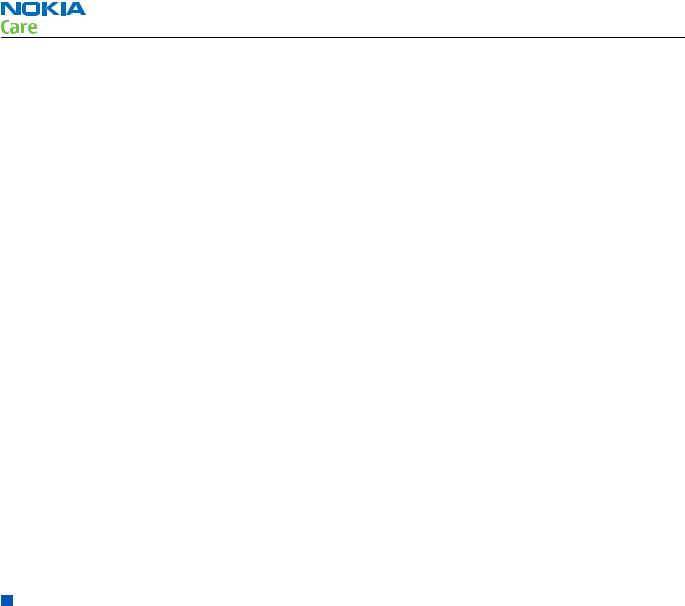
RM-320
General Information
|
Table 4 GPS |
|
|
|
|
Enhancement |
|
Type |
Wireless GPS module |
|
LD-3W |
|
|
|
Navigation pack |
|
LD-2 |
|
|
|
|
Table 5 Messaging |
|
|
|
|
Enhancement |
|
Type |
Digital pen |
|
SU-27W |
|
|
|
Wireless keyboard |
|
SU-8W |
|
|
|
|
Table 6 Power |
|
|
|
|
Enhancement |
|
Type |
Battery 1200mAh Li-ion |
|
BL-6F |
|
|
|
Travel charger |
|
AC-4 |
|
|
|
|
|
AC-5 |
|
|
|
Charger adapter |
|
CA-44 |
|
|
|
|
Table 7 Carrying |
|
|
|
|
Enhancement |
|
Type |
Carrying case |
|
|
|
|
|
Technical specifications
Transceiver general specifications
Unit |
Dimensions (L x W x T) |
Weight (g) |
Volume (cm3) |
|
(mm) |
|
|
Transceiver with BL-6F |
99 x 53 x 19-21 |
~ 120 |
90 |
1200mAh li-ion battery |
|
|
|
back |
|
|
|
|
|
|
|
Main RF characteristics for GSM850/900/1800/1900 and WCDMA 2100 phones
Parameter |
Unit |
Cellular system |
GSM850, EGSM900, GSM1800/1900, WCDMA 2100 |
|
|
Page 1 –10 |
COMPANY CONFIDENTIAL |
Issue 1 |
|
Copyright © 2007 Nokia. All rights reserved. |
|
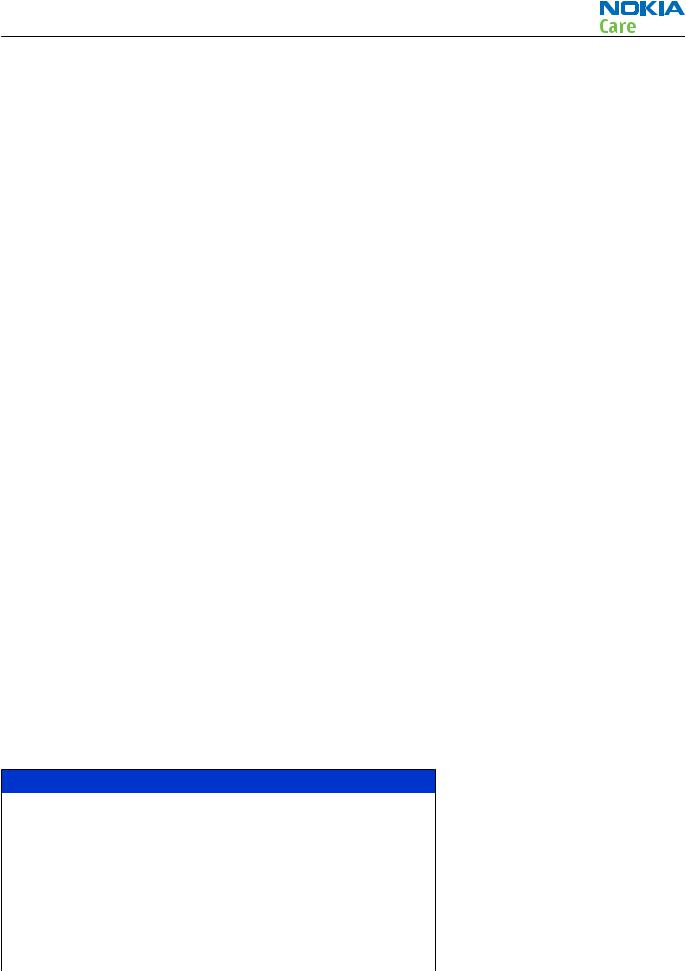
RM-320
General Information
Parameter |
Unit |
Rx frequency band |
GSM850: 869 - 894MHz |
|
|
|
EGSM900: 925 - 960 MHz |
|
|
|
GSM1800: 1805 - 1880 MHz |
|
|
|
GSM1900: 1930 - 1990 MHz |
|
|
|
WCDMA2100: 2110 - 2170 MHz |
|
|
Tx frequency band |
GSM850: 824 - 849MHz |
|
|
|
EGSM900: 880 - 915 MHz |
|
|
|
GSM1800: 1710 - 1785 MHz |
|
|
|
GSM1900: 1850 - 1910 MHz |
|
|
|
WCDMA2100: 1920 - 1980 MHz |
|
|
Output power |
GSM850: +5 ...+33dBm/3.2mW ... 2W |
|
|
|
GSM900: +5 … +33dBm/3.2mW … 2W |
|
|
|
GSM1800: +0 … +30dBm/1.0mW … 1W |
|
|
|
GSM1900: +0 … +30dBm/1.0mW … 1W |
|
|
|
WCDMA -50 … 24 dBm |
|
|
Number of RF channels |
GSM850: 124 |
|
|
|
GSM900: 174 |
|
|
|
GSM1800: 374 |
|
|
|
GSM1900: 299 |
|
|
Number of WCDMA channels |
WCDMA: 277 |
|
|
Channel spacing |
200 kHz |
|
|
Number of Tx power levels |
GSM850: 15 |
|
|
|
GSM900: 15 |
|
|
|
GSM1800: 16 |
|
|
|
GSM1900: 16 |
|
|
Battery endurance
Battery BL-6F 1200 mAh
Music Playback time |
10.5 h |
|
|
Talk time (GSM/UMTS) |
4.9/3.4 h |
|
|
Standby time (GSM/UMTS) |
188 / 228 h |
|
|
Video Playback time |
5h 14min |
|
|
Video Call |
1.91 h |
|
|
Still Images without charging |
372 images |
|
|
Video Recording |
2h 6min |
|
|
Issue 1 |
COMPANY CONFIDENTIAL |
Page 1 –11 |
|
Copyright © 2007 Nokia. All rights reserved. |
|

RM-320
General Information
|
Battery BL-6F 1200 mAh |
|
Browse time (3G) |
|
4.3 h |
|
|
|
Charging times
AC-5
1h 30 min
Page 1 –12 |
COMPANY CONFIDENTIAL |
Issue 1 |
|
Copyright © 2007 Nokia. All rights reserved. |
|
Nokia Customer Care
2 — Service Tools and Service
Concepts
Issue 1 |
COMPANY CONFIDENTIAL |
Page 2 –1 |
|
Copyright © 2007 Nokia. All rights reserved. |
|

RM-320
Service Tools and Service Concepts
(This page left intentionally blank.)
Page 2 –2 |
COMPANY CONFIDENTIAL |
Issue 1 |
|
Copyright © 2007 Nokia. All rights reserved. |
|

RM-320
Service Tools and Service Concepts
|
Table of Contents |
|
Service tools............................................................................................................................................................ |
|
2–5 |
CA-31D ................................................................................................................................................................ |
|
2–5 |
CA-35S................................................................................................................................................................. |
|
2–5 |
CU-4..................................................................................................................................................................... |
|
2–6 |
DKE-2................................................................................................................................................................... |
|
2–7 |
FPS-10................................................................................................................................................................. |
|
2–7 |
FS-70 ................................................................................................................................................................... |
|
2–7 |
MJ-102................................................................................................................................................................. |
|
2–8 |
PCS-1 ................................................................................................................................................................... |
|
2–8 |
PKD-1 .................................................................................................................................................................. |
|
2–8 |
RJ-105 ................................................................................................................................................................. |
|
2–9 |
RJ-118 ................................................................................................................................................................. |
|
2–9 |
RJ-157 ................................................................................................................................................................. |
|
2–9 |
RJ-160 ................................................................................................................................................................. |
|
2–9 |
RJ-166 .............................................................................................................................................................. |
|
2–10 |
RJ-169 .............................................................................................................................................................. |
|
2–10 |
RJ-93 ................................................................................................................................................................ |
|
2–10 |
SA-106 ............................................................................................................................................................. |
|
2–10 |
SA-131 ............................................................................................................................................................. |
|
2–11 |
SB-6.................................................................................................................................................................. |
|
2–11 |
SB-7.................................................................................................................................................................. |
|
2–11 |
SPS-2 ................................................................................................................................................................ |
|
2–11 |
SRT-6................................................................................................................................................................ |
|
2–12 |
SS-46 ................................................................................................................................................................ |
|
2–12 |
SS-62 ................................................................................................................................................................ |
|
2–12 |
SS-93 ................................................................................................................................................................ |
|
2–12 |
ST-38................................................................................................................................................................ |
|
2–13 |
ST-40................................................................................................................................................................ |
|
2–13 |
ST-53................................................................................................................................................................ |
|
2–13 |
ST-55................................................................................................................................................................ |
|
2–13 |
ST-59................................................................................................................................................................ |
|
2–13 |
SX-4.................................................................................................................................................................. |
|
2–14 |
XCS-1 ................................................................................................................................................................ |
|
2–14 |
XCS-4 ................................................................................................................................................................ |
|
2–14 |
XRS-6................................................................................................................................................................ |
|
2–14 |
Service concepts .................................................................................................................................................. |
|
2–15 |
POS (Point of Sale) flash concept .................................................................................................................. |
|
2–15 |
Flash concept with FPS-10............................................................................................................................. |
|
2–16 |
CU-4 flash concept with FPS-10..................................................................................................................... |
|
2–17 |
Flash concept with FPS-10 and JBT-9 ........................................................................................................... |
|
2–18 |
Flash concept with SS-46 and CA-89DS ........................................................................................................ |
|
2–19 |
Flash concept with CA-89DS .......................................................................................................................... |
|
2–20 |
Flash concept with SS-62 and CA-89DS ........................................................................................................ |
|
2–21 |
Flash concept with FPS-10, SS-62 and JBT-9................................................................................................ |
2–22 |
|
Flash concept with FPS-10, SS-62 and SB-7 ................................................................................................. |
2–23 |
|
Module jig service concept ............................................................................................................................ |
|
2–24 |
Module jig service concept with JBT-9 and smart card reader .................................................................. |
2–25 |
|
Module jig service concept with JBT-9 ......................................................................................................... |
|
2–26 |
RF testing concept with RF coupler .............................................................................................................. |
|
2–27 |
Service concept for RF testing and RF/BB tuning ........................................................................................ |
2–28 |
|
|
|
|
Issue 1 |
COMPANY CONFIDENTIAL |
Page 2 –3 |
Copyright © 2007 Nokia. All rights reserved.

|
|
|
RM-320 |
|
|
|
Service Tools and Service Concepts |
List of Figures |
|
||
Figure 1 POS flash concept ................................................................................................................................. |
2–15 |
||
Figure 2 Basic flash concept with FPS-10.......................................................................................................... |
2–16 |
||
Figure 3 CU-4 flash concept with FPS-10........................................................................................................... |
2–17 |
||
Figure 4 Flash concept with FPS-10 and JBT-9 ................................................................................................. |
2–18 |
||
Figure 5 Flash concept with SS-46 and CA-89DS .............................................................................................. |
2–19 |
||
Figure 6 |
Flash concept with CA-89DS ................................................................................................................ |
2–20 |
|
Figure 7 |
Flash concept with SS-62 and CA-89DS .............................................................................................. |
2–21 |
|
Figure 8 |
Flash concept with FPS-10, SS-62 and JBT-9 ...................................................................................... |
2–22 |
|
Figure 9 |
Flash concept with FPS-10, SB-7 and JBT-9........................................................................................ |
2–23 |
|
Figure 10 Module jig service concept ................................................................................................................ |
2–24 |
||
Figure 11 |
Service concept with JBT-9 and smart card reader......................................................................... |
2–25 |
|
Figure 12 |
Module jig service concept with JBT-9 ............................................................................................. |
2–26 |
|
Figure 13 |
RF testing concept with RF coupler .................................................................................................. |
2–27 |
|
Figure 14 |
Service concept for RF testing and RF/BB tuning............................................................................ |
2–28 |
|
Page 2 –4 |
COMPANY CONFIDENTIAL |
Issue 1 |
|
Copyright © 2007 Nokia. All rights reserved. |
|
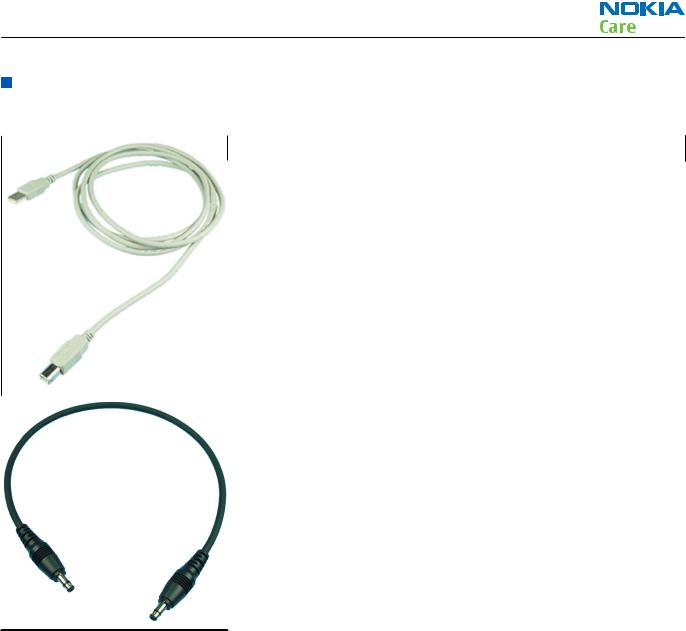
RM-320
Service Tools and Service Concepts
Service tools
The table below gives a short overview of service tools that can be used for testing, error analysis and repair of product RM-320, refer to various concepts.
|
CA-31D |
USB cable |
|
|
|
|
|
The CA-31D USB cable is used to connect FPS-10 or FPS-11 to a PC. It is included in the FPS-10 and FPS-11 sales packages.
|
CA-35S |
Power cable |
|
|
|
|
|
CA-35S is a power cable for connecting, for example, the FPS-10 flash prommer to the Point-Of-Sales (POS) flash adapter.
Issue 1 |
COMPANY CONFIDENTIAL |
Page 2 –5 |
|
Copyright © 2007 Nokia. All rights reserved. |
|
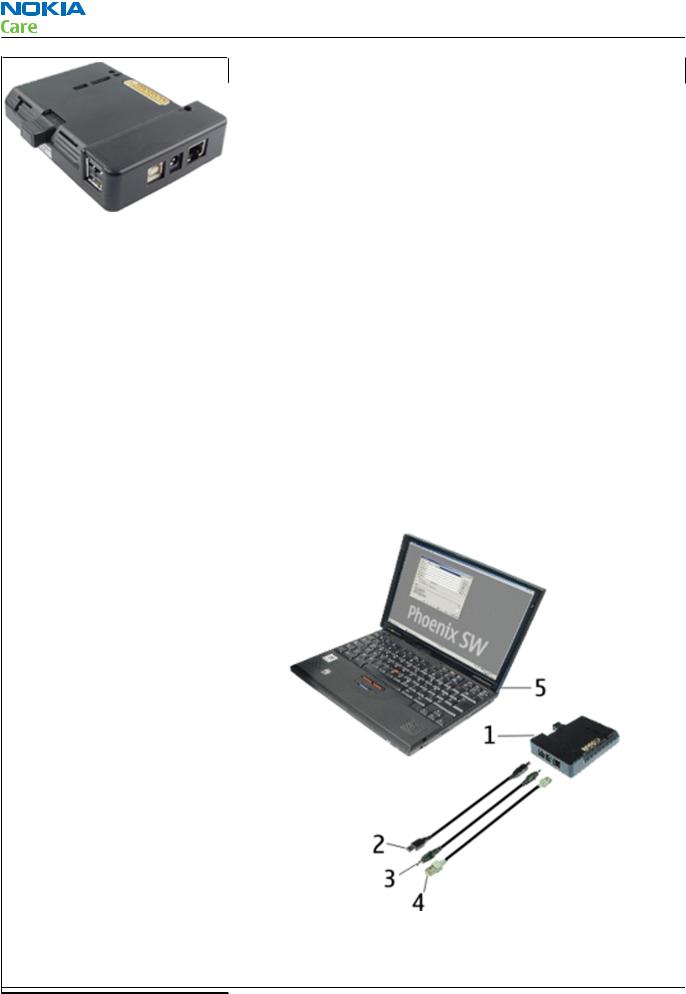
RM-320
Service Tools and Service Concepts
CU-4 |
Control unit |
|
|
|
|
CU-4 is a general service tool used with a module jig and/or a flash adapter. It requires an external 12 V power supply.
The unit has the following features:
•software controlled via USB
•EM calibration function
•Forwards FBUS/Flashbus traffic to/from terminal
•Forwards USB traffic to/from terminal
•software controlled BSI values
•regulated VBATT voltage
•2 x USB2.0 connector (Hub)
•FBUS and USB connections supported
When using CU-4, note the special order of connecting cables and other service equipment:
Instructions
1Connect a service tool (jig, flash adapter) to CU-4.
2Connect CU-4 to your PC with a USB cable.
3Connect supply voltage (12 V)
4Connect an FBUS cable (if necessary).
5Start Phoenix service software.
Note: Phoenix enables CU-4 regulators via USB when it is started.
Reconnecting the power supply requires a Phoenix restart.
Page 2 –6 COMPANY CONFIDENTIAL Issue 1 Copyright © 2007 Nokia. All rights reserved.
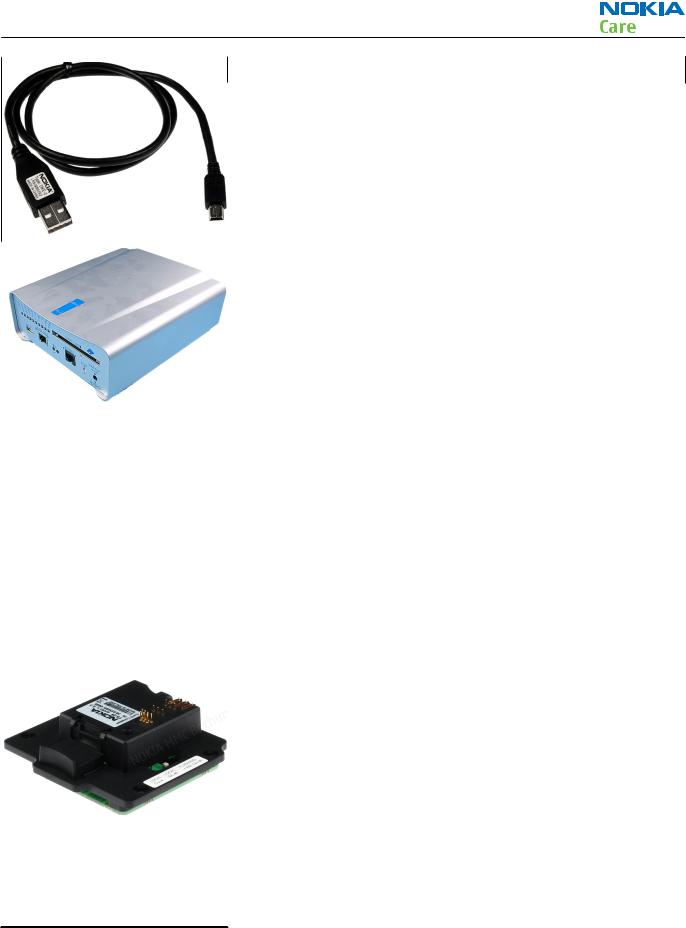
RM-320
Service Tools and Service Concepts
|
DKE-2 |
Mini-USB cable |
|
|
|
|
|
USB to mini-USB connector cable.
|
FPS-10 |
Flash prommer |
|
|
|
|
|
FPS-10 interfaces with:
•PC
•Control unit
•Flash adapter
•Smart card
FPS-10 flash prommer features:
•Flash functionality for BB5 and DCT-4 terminals
•Smart Card reader for SX-2 or SX-4
•USB traffic forwarding
•USB to FBUS/Flashbus conversion
•LAN to FBUS/Flashbus and USB conversion
•Vusb output switchable by PC command
FPS-10 sales package includes:
•FPS-10 prommer
•Power Supply with 5 country specific cords
•USB cable
Note: FPS-21 is substitute FPS-10 if FPS-10 has not been set up.
|
FS-70 |
Flash adapter |
|
|
|
|
|
Flash adapter FS-70 is used for phone testing and flashing. FS-70 is used with the generic flash adapter base SS-60/62 and control unit CU-4 or interface adapter SS-46.
When flashing or system testing the phone, the adapter is attached to replace the phone own battery.
All functions (as well as the calibration voltages, current and the protections for over voltages, over current and voltage polarity), are performed by CU-4.
Flash adapter FS-70 main features:
•VBATT supply interface
•USB / FBUS multiplexed interface to the phone
Issue 1 |
COMPANY CONFIDENTIAL |
Page 2 –7 |
|
Copyright © 2007 Nokia. All rights reserved. |
|
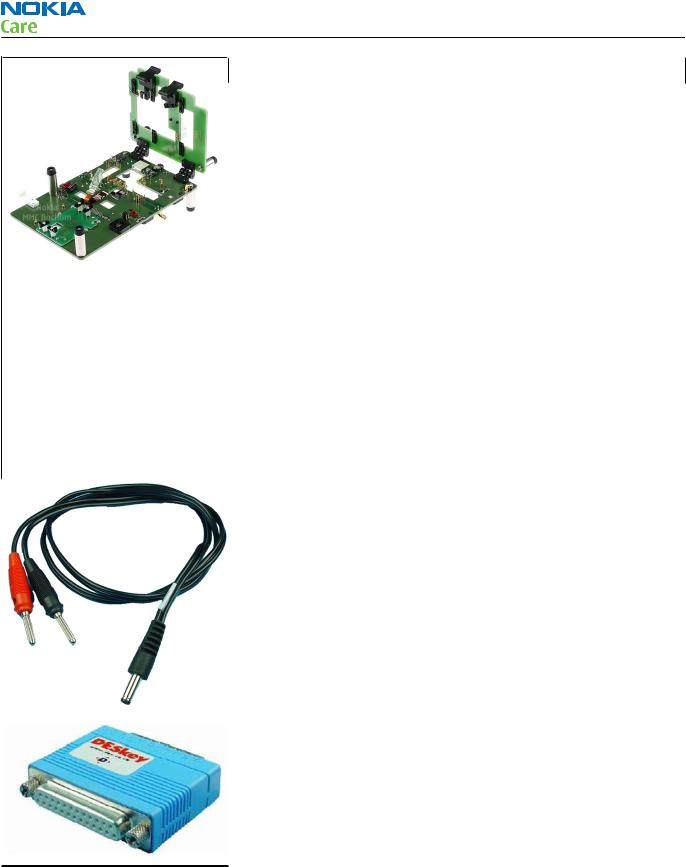
RM-320
Service Tools and Service Concepts
MJ-102 |
Module jig |
|
|
|
|
MJ-102 can be used for flashing as well as for RF, battery and system testing.
MJ-102 main functions:
•CU-4 interface adapter to phone
•FBUS interface to phone
•UI Interface to phone
•WCDMA and GSM RF-interface
All functions are performed in CU-4 e.g. calibration voltages and currents both all protections (over current, over voltage and voltage polarity).
MJ-102 contains following interfaces to phone:
•VBATT interface
•UI interface containing Display connector
•WCDMA and GSM RF interfaces
•Bluetooth RF interface
•Earpiece interface
•IHF speaker interface
•Microphone interface
|
PCS-1 |
Power cable |
|
|
|
|
|
The PCS-1 power cable (DC) is used with a docking station, a module jig or a control unit to supply a controlled voltage.
|
PKD-1 |
SW security device |
|
|
|
|
|
SW security device is a piece of hardware enabling the use of the service software when connected to the parallel (LPT) port of the PC.
Without the device, it is not possible to use the service software.
Printer or any such device can be connected to the PC through the device if needed.
Page 2 –8 |
COMPANY CONFIDENTIAL |
Issue 1 |
|
Copyright © 2007 Nokia. All rights reserved. |
|
